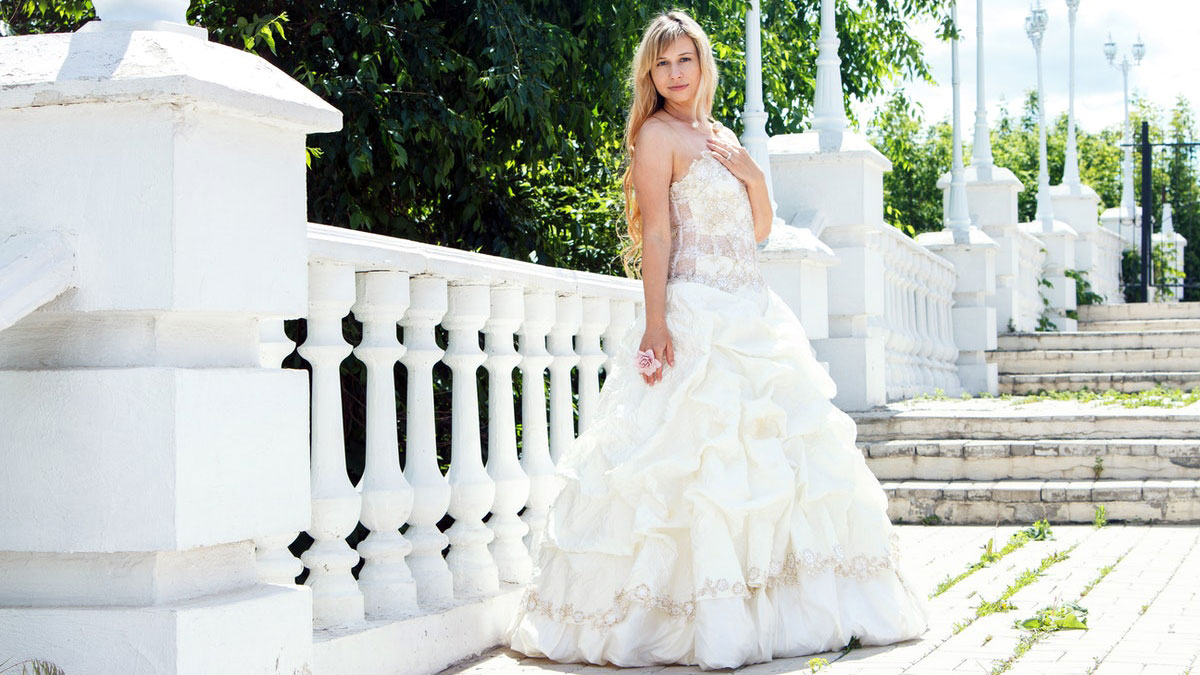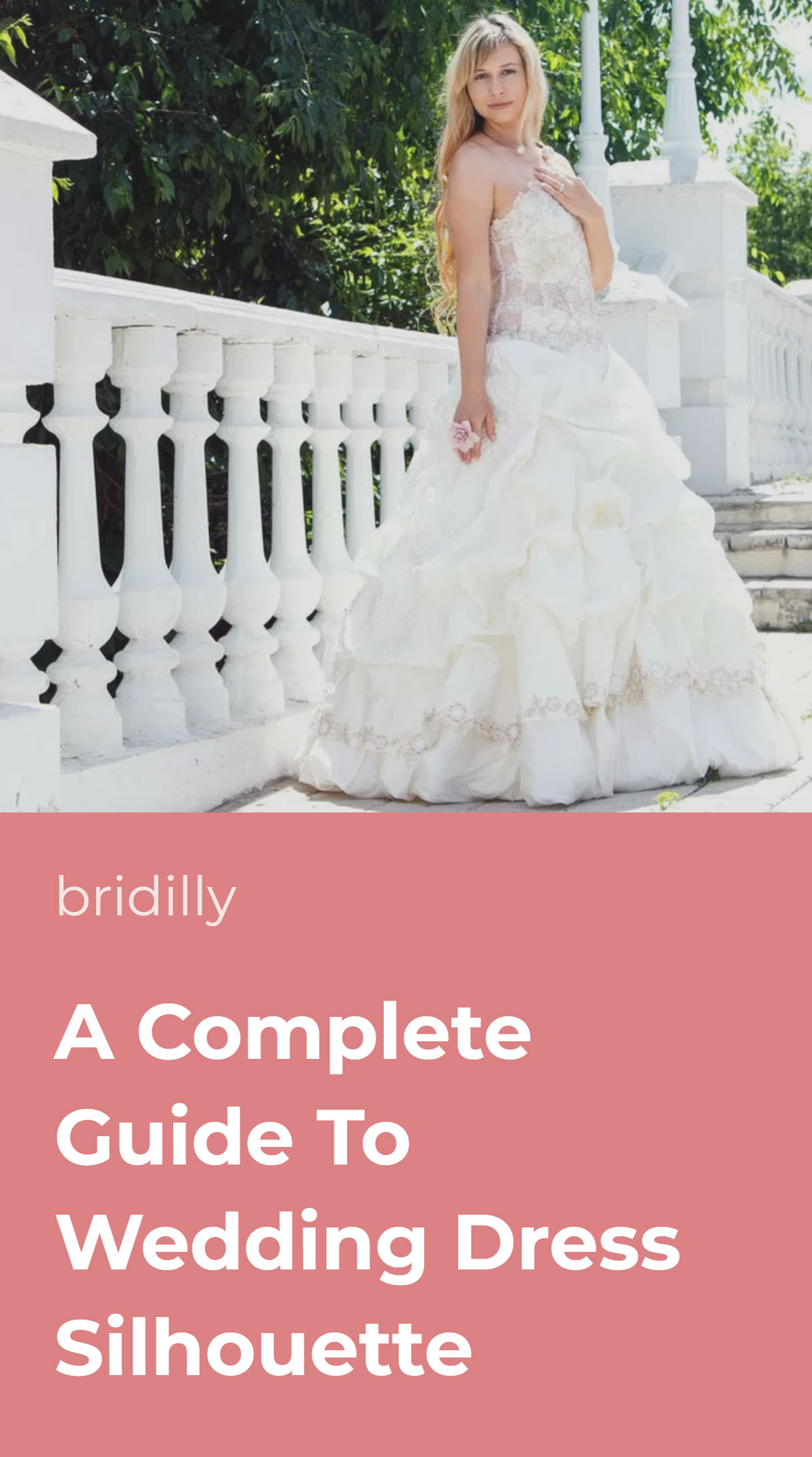Before you head to the local bridal salon, it’s worth researching a wedding dress silhouette guide to determine your favorites.
Each wedding dress is beautiful and unique, but not every style will flatter your figure and be appropriate for the setting.
If you have no idea what’s the difference between a mermaid and trumpet silhouette and think that terms sheath and column can be used interchangeably, you aren’t yet ready for wedding dress shopping.
Your wedding gown is the mirror of your personality, a fashion statement, and a sentimental piece. For many brides, saying “yes” to the dress is nearly as stressful as saying it at the altar.
Thankfully, narrowing down the selection becomes much easier as you learn the characteristics of each silhouette and which styles better fit your body type.
Table of Contents [show]
A-Line
A-line is the most traditional, popular wedding dress style. It’s a universal silhouette that fits any wedding style, from bohemian to black tie, and flatters any body type. When in doubt, go for an A-line gown.
This silhouette is characterized by a fitted bodice and gradually flaring from the waist skirt, resembling the capital letter “A.”
The skirt is never tight or too voluminous – it should be gathered at the top and flowy at the bottom.
Unlike ball gowns, A-line dresses are flat against the stomach. The proportions are well-balanced, without dramatic contrast.
This wedding dress silhouette accentuates the waist but won’t create the appearance of curves if you don’t have any.
A-line wedding dresses beautifully elongate the figure and are perfect for petite brides. However, if you want to achieve a dramatic or sexy bridal look, an A-line silhouette may be way too classic and modest.
Ball Gown
The ball gown silhouette is a dramatic take on the A-line style, featuring a fitted bodice and an extremely voluminous, full skirt.
Unlike A-line skirt, ball gown skirt doesn’t flare gradually – the transitioning from the waist to the hips is always apparent.
Skirt’s fullness can be achieved by multiple fabric layers, crinoline, hooped underskirt, or all at once. The bodice is often corseted to enhance the contrast between slim waist and wide hips.
The ball gown is the ultimate princess-style wedding dress silhouette that demands a worthy setting. It certainly isn’t an option for a laid-back backyard wedding but will look gorgeous in a church or castle.
Ball gowns are ideal for brides with an inverted triangle body type because the wide skirt balances the shoulders.
Curvy brides will appreciate how ball gowns enhance the proportion contrast, making the waist appear even smaller and bust even fuller.
Petite brides may want to consider A-line dresses instead of ball gowns because the voluminous skirt shortens the figure and makes it appear bulkier.
Mermaid
Mermaid is undoubtedly the most seductive and the least comfortable wedding dress silhouette.
It’s a dramatic variation of the fit and flare silhouette, fitted at the top and flared at the bottom. This silhouette resembles a fishtail, hence the name.
Mermaid gowns often have corseted bodices to enhance the waist and flatten the stomach. The skirt is fitted at the hips and thighs and flares from the knees. The flare can be gradual or dramatic, depending on the style.
Mermaid wedding dresses are ideal for brides with a pear or hourglass body type because the silhouette hugs the figure, accentuating the bust, waist, and hips.
However, a corset can also help brides with a rectangle body type create the appearance of curves.
Most importantly, you should be confident enough to wear a mermaid wedding dress. Consider a different style if you’re concerned about maintaining a slim profile throughout the day.
This wedding dress cut fits exquisite venues and may look over the top at a laid-back rustic wedding.
Note that mermaid gowns aren’t your best bet if you plan to hit the dancefloor. You may also need assistance when taking the stairs.
Trumpet
The trumpet style is often confused with mermaid cut. The difference between mermaid vs. trumpet wedding dress style is where the flare begins. In trumpet gowns, the flare starts higher than in mermaid dresses, at the mid-thigh.
Furthermore, the flare is usually more gradual than in mermaid gowns. Trumpet wedding dresses look impeccably elegant and classy without excessive drama.
Same as the mermaid silhouette, the trumpet cut looks the best on curvy brides with harmonious figures. However, it can also help women with broad shoulders balance proportions.
Trumpet style is also more comfortable than the mermaid cut because it doesn’t chinch the knees. It’s an excellent choice if you wish to accentuate curves without sacrificing your comfort.
Empire
The empire silhouette has been around since ancient times. This modest style features a high waist that sits just below the bust and a straight, flowy skirt.
The empire silhouette is similar to the column, but the latter doesn’t have a defined waistline.
Empire wedding dresses are perfect for brides who want to hide tummy fat or pregnant brides who want to avoid extensive alterations. The empire silhouette also flatters petite brides because it elongates the legs.
This wedding gown style was made for bohemian, rustic, whimsical, and beach weddings, giving an aerial, carefree feel to your bridal look.
However, some empire gowns feature intricate embellishments and are black-tie event worthy.
Tea-Length
Tea-length wedding dresses are the 1950s style staple, featuring full, swinging skirts ending between the mid-calf and ankle. It’s the most popular style for retro-themed weddings but can also fit other themes if styled correctly.
A tea-length wedding gown is a middle ground between tradition and fashion statement, combining modesty and playfulness. It’s a chic choice for a laid-back wedding ceremony in vintage, whimsical, or alternative style.
On the other hand, a tea-length dress with a crystal tiara and shiny high heels is a princess-worthy look that will fit the most exquisite venue. It’s a comfortable alternative to a ball gown.
Tea-length dresses typically have fitted bodices and beautifully accentuate curves, so they are favored by brides with pear and hourglass body types. This style also helps to balance broad shoulders.
Note that tea-length dresses visually shorten the legs and aren’t a great fit for petite brides. Furthermore, they look the best with cat heels or flats.
High-Low
High-low wedding gowns are always a fashion statement, favored by creative brides seeking an alternative look. Consider high-low hemlines if you find A-line gowns boring and mermaid dresses too uncomfortable.
Many women find this wedding dress style tacky due to its popularity in the 2000s. However, high-low gowns can be very different.
Some high-low dresses have a subtle difference between the front and the back and minimalist detailing, creating an endlessly classy look with a twist; others combine an extra-short front with a cathedral train for a dramatic appearance.
A high-low wedding dress is a perfect way to showcase your legs and bridal heels while staying appropriate for the occasion. It’s a very comfortable wedding dress style for dancing, apart from dresses with a long train.
Column
The column is a modest, classic wedding dress style. You can recognize it by a straight silhouette without accentuated waist or flaring skirt.
Because the waist isn’t defined, column dresses are perfect for brides concerned about tummy fat.
Column style doesn’t showcase curves like the mermaid or trumpet silhouettes but emphasizes the height.
Its straight lines visually elongate legs, making it ideal for petite brides. Meanwhile, chubby brides will appreciate how column gowns make them appear slimmer.
Column wedding dresses fit any style and setting. Whether you prefer minimalist slip gowns or Art Deco-inspired fringed dresses, there’s a style for everyone.
This dress style was made for brides who value comfort and don’t care about the wow-factor, preferring elegance over drama.
Column dresses are often confused with sheath gowns. The silhouettes are similar, but the former has a more relaxed, seamless cut, and the latter contours the body from head to toe but not as much as mermaid gowns.
Which Silhouette Should You Choose?
If you’re wondering how to choose a wedding dress silhouette, consider your body type, personality, and reception style. The perfect wedding dress should flatter your figure and be appropriate for the setting.
Adequately evaluate your best features and think which body parts you want to conceal. For instance, if you’re proud of your curves, hiding them under an empire gown is a sacrilege, while a mermaid dress or ball gown will enhance the lines.
On the other hand, if you’d like to hide the tummy and back fat but don’t mind showing your legs, consider an empire gown with a high-low hemline. Don’t forget to choose the right neckline and sleeve style.
If you plan a retro-themed wedding, opt for a tea-length dress rather than a long ball gown, and if you host a rustic barn wedding, choose a relaxed, flowy silhouette.
Additionally, consider the season and your comfort. Flowy styles are better than tight silhouettes for active brides who love to dance, whereas a mermaid-cut dress with a train will look beyond gorgeous at a church ceremony.
Choose an A-line gown if you struggle to pick a dress to fit your body type and wedding venue.
This style is truly universal – it equally well suits brides with a rectangle, inverted triangle, and pear body types and fits rustic, beach, and castle settings.



















No Comments Add one
Leave a Comment